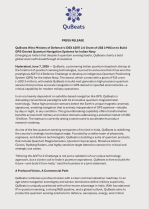5 Professors, 2 PhD Scholars, 15 Years: Inside Agnit’s Moonshot to Secure India’s Defence Systems
Shruti Tripathi
Updated on: 28 June 2025 2:39 pm
In the heart of Bengaluru’s academic enclave, a daring experiment in Gallium Nitride defied odds, bureaucracy, and conventional wisdom. What emerged is Agnit and through it, India’s strategic moonshot in semiconductors
5 Professors, 2 PhD Scholars, 15 Years: Inside Agnit’s Moonshot to Secure India’s Defence Systems
In 2006, deep inside the wooded campus of the Indian Institute of Science (IISc) in Bangalore, a quiet collaboration was taking shape. Five professors and two PhD scholars—each steeped in the rigors of academia and driven by a shared conviction—decided to venture into uncharted territory: Gallium Nitride. GaN, as it is known in engineering shorthand, was a formidable compound, celebrated for its wide bandgap and unique electronic properties. Globally, it was already making ripples in strategic sectors like defence, aerospace, and high-frequency communications. In India, however, it was barely a whisper—too complex, too specialized, and too dependent on foreign suppliers to be considered viable.
But that unfamiliarity made it all the more compelling. Over the next 15 years, these scientists toiled in relative obscurity—publishing, prototyping, filing patents—slowly constructing an edifice of intellectual capital that could disrupt an entire industry. It was a mission that demanded endurance more than excitement, and far more faith than fanfare.
In 2019, that long incubation culminated in the birth of Agnit Semiconductors, India’s first start-up dedicated to GaN technologies. Helmed by Hareesh Chandrasekar, Shankar Kumar Selvaraja, Madhusudan Atre, Muralidharan Rangarajan, Srinivasan Raghavan—fondly called Vasu—and Mayank Shrivastava, Agnit is one of the rare Indian deep tech startups born in an academic setting.
Setting Agnit apart is the uniqueness of GaN, a material whose capabilities are not merely incremental but transformative
. Unlike traditional silicon-based semiconductors, GaN enables electronics to run faster, cooler, and more efficiently. These qualities make it ideal for applications that demand high power and high frequency—radars, jammers, satellites, and next-generation wireless systems. Simply put, GaN does what silicon cannot.
“This is certainly not an overnight effort,” Chandrasekar, Agnit’s CEO, explains. “When I say we have manufacturing IP, I mean we don’t just design these chips—we actually make them. That’s a rarity in India.”
Betting on Both Sides of the Equation
Designing semiconductors is difficult. Manufacturing them is exponentially harder. Most start-ups in India take the design-only route—it’s less capital-intensive, faster to market, and far more attractive to risk-averse investors. Agnit, however, chose the harder path. It invested in building end-to-end capabilities: from material research and chip architecture to foundry partnerships and fabrication know-how. This duality—owning both the design and manufacturing IP—distinguishes Agnit not only in India but globally.
The company’s current focus is sharply aligned with India’s strategic imperatives. GaN’s performance advantage makes it an ideal candidate for mission-critical systems. “Because it is an outperformer,” says Chandrasekar. “Naturally suited for defence-grade applications like next-gen radar and secure communications—systems where failure is not an option.
”
India’s Ministry of Defence has in recent years pushed aggressively for the indigenisation of such technologies, encouraging the development of home-grown alternatives to imported hardware. Agnit’s all-Indian supply chain, its domestic R&D, and its sovereignty-first model fit right in. “Our value to the defence ecosystem lies in the fact that we don’t just design these solutions—we manufacture them here, in India. That end-to-end capability is crucial,” Chandrasekar adds.
Co-founder Muralidharan Rangarajan points out that GaN’s appeal goes well beyond defence. It is equally critical to next-generation telecom infrastructure, satellite communications, and electric vehicles. In a decarbonising world driven by speed and scale, GaN is fast becoming the material of strategic consequence
.
The iDEX Catalyst
Still, ambition needs acceleration. That came in the form of iDEX—the Innovations for Defence Excellence initiative set up by the Indian government to foster indigenous technological innovation in military applications. iDEX identified Agnit early and awarded it ₹1.5 crore under an Open Challenge for developing GaN semiconductor components tailored for defence electronics.
That grant, while modest in the scale of semiconductor economics, was a turning point, an important endorsement. It conferred legitimacy and brought Agnit into the conversation about India’s strategic future. “iDEX wasn’t just a funding platform—it was a signal,” says Srinivasan Raghavan. “It told the ecosystem that building this in India was not only possible but urgent.”
What also distinguished iDEX was its enlightened IP policy. While it funds the development of proprietary technologies, it allows start-ups to retain their IP. The government only reserves the right to step in if the start-up fails to commercialise the technology within a reasonable period, in which case it can deploy it in national interest.
“For IP-driven companies like ours, that clarity is everything,” Chandrasekar explains. “Investors don’t just invest in teams—they invest in clean IP.”
Capital, Constraints, and the Long Road
Agnit’s journey has been anything but smooth. Since 2021, the start-up has raised approximately $4.8 million—$3.5 million of that in a seed round led by 3one4 Capital, with participation from Zephyr Peacock and former Cognizant CEO Lakshmi Narayanan.
"We supported Agnit because their IISc-based team is leading the development of vertically‑integrated GaN semiconductors crucial for India’s energy, 5G, EV, and strategic imperatives. We believe investing in deep‑tech from India’s top academic institutions is essential to the country’s VC ecosystem. Agnit, emerging from rigorous and globally competitive research, demonstrates how robust, locally grounded technical foundations can drive national missions for semiconductor self‑reliance," said Pranav Pai, founding partner of 3One4 Capital.
But in deep-tech, capital requirements scale rapidly. Designing chips is expensive, fabricating them even more so. Building a production-ready, qualification-tested prototype can cost anywhere between $2 million and $4 million, and the development cycle often spans two to four years.
“Unlike software, where you can iterate quickly, in semiconductors each mistake can cost you millions,” says Chandrasekar. “And even if you get the physics right, getting it to work in real-world conditions is a whole different beast.”
That’s why Agnit’s founders believe India needs more robust support mechanisms. iDEX is an excellent start, but it must be scaled. The missing link, they argue, is what they call “viability gap funding”—capital that bridges the time between product viability and commercial traction.
Equally vital are procurement commitments. If government departments or PSUs could offer even modest long-term purchase contracts, it would de-risk R&D and make capital infusion from private investors far more likely. “The market for GaN exists,” says Raghavan. “But early adopters must signal intent. Otherwise, we’re stuck in a proof-of-concept limbo.”
Despite these hurdles, Agnit is pushing forward. The company is currently engaged in five pilot projects—three with Defence Public Sector Undertakings (DPSUs) and two with private players in the defence sector. Early tests are promising. More importantly, the strategic relevance of what they’re building is undeniable.
The broader context also favours them. According to the India Electronics and Semiconductor Association (IESA), India’s semiconductor market is expected to nearly double—from ₹4.5 lakh crore ($52 billion) in 2024 to ₹8.95 lakh crore ($103.4 billion) by 2030. This growth will be driven by mobile handsets, consumer electronics, automotive systems, and defence technology.
“But you don’t build technological resilience with services alone. You do it with products. You do it with IP. You do it with conviction,
” asserts Chandrashekhar.
The Global GaN Frontier
None of this is happening in a vacuum. Globally, the GaN semiconductor race is intensifying. American firms like Qorvo and Wolfspeed, Japanese giants like Sumitomo Electric, and German powerhouses like Infineon are all investing heavily in GaN technologies. These companies operate with massive capital reserves and decades of ecosystem experience.
And yet, Agnit sees room to grow.
“We’re building for strategic clarity. For independence. And for the long game,” says Chandrasekar says.
That focus includes a complete commitment to R&D, local partnerships, and export-readiness. Agnit’s leadership is aware that building an IP-led product company in India is both rare and risky. But it’s also necessary.
“For the longest time, we’ve said India can’t build chips. We’ve proved otherwise,” says Chandrasekar. “Now we want to prove we can lead.”
With the right support—financial, regulatory, and strategic—Agnit could well become the vanguard of India’s deep-tech renaissance. Not just a torchbearer for GaN, but a case study in how vision, grit, and science can bend the arc of national capability.
5 Professors, 2 PhD Scholars, 15 Years: Inside Agnit’s Moonshot To Secure India’s Defence Systems From IISc Campus










